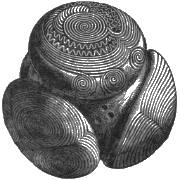Canmore Site 63590: LOCH DOON, DONALD'S ISLE - STRAITON (CUMNOCK AND DOON VALLEY) - SETTLEMENT (MEDIEVAL)
Description
| Site Name | LOCH DOON, DONALD'S ISLE |
|---|---|
| Other Name(s) | LAMDOUGHTY FARM, 'MONKS GRAVES', ISLE DONAN, LOCH DOON RESERVOIR |
| Site Number | NX49NE 1 |
| Broad Class | DOMESTIC |
| Site Type(s) | SETTLEMENT (MEDIEVAL) |
| NGR | NX 4943 9655 |
| NGR accuracy | NGR given to the nearest 10m |
| Local Authority | EAST AYRSHIRE |
| Parish | STRAITON (CUMNOCK AND DOON VALLEY) |
| Record created | 1988-07-04 |
| Last updated | 2011-01-13 |
Archaeology Notes
NX49NE 1 4943 9655
'An island in Loch Doon. This island perpetuates the name of a dreamy ascetic the foundation course of whose habitation is still above ground. Tradition has it that Donald's bones lie bleaching in the water that encircled him in life. Donald's notorious weakness for a less gentle liquid is still deplored in the neighbourhood.'
OS Name Book 1858.
(NX 4941 9655). Structures formerly known as 'Monks Graves' (J Smith) on Donald's Isle formerly Isle Donan (T Pont 1596) were excavated in 1933-36 in the belief that they might prove to be the remains of an early monastic establishment. All the evidence however points to this having been a medieval domestic site, possibly a 13th-14th c timber hall-house (A E Truckell and J Williams 1967) (cf NX54NE 6).
The island itself, now submerged but periodically exposed, is of granite blocks and debris. The main structure on the island was a rectangular boulder foundation, 43' by 12'4, within walls c 8' thick with a single entrance in the west wall. Attached to this on the north was a secondary walled structure, with beyond it evidence of a timber building in the form of a horse-shoe setting of stones and many flat-headed iron nails. To the south of the main structure were the remains of an elongated hut formed of boulders. A setting of stones, apparently springing from the NW corner of the main structure, enclosed the complex except on the SW. Outside this on the west was a boat jetty.
A 1260 coin was recovered from the infill of the hut and much medieval pottery was found. Early occupation of the site is indicated by the finding of flints at the old surface level, these probably being comparable with worked and unworked flints of Mesolithic aspect found on the island in 1969 (Proc Soc Antiq Scot 1881). A segment of 1st-2nd century AD (H E Kilbride-Jones 1938) glass armlet was found in the infill of the main structure.
The objects from the excavation and others found previously are in the NMAS (Acc Nos HT 6-9, BG 390, FJ 144, AB 2619-26 MEA 12).
OS 6" map (1856); A Fairbairn 1937; M L Ansell 1969.
NX 4943 9655. At present the level of Loch Doon is abnormally low and although Donald's Isle itself is not visible the remains of a rectangular building 15.0m NS by 5.0m with another building 5.0m square to the S can be seen from the shore.
Visited by OS (BS) 2 June 1976
The remains of two rectangular buildings stand on the highest point of Donald's Isle, a small island in Loch Doon which, since the level of the loch was artificially raised, is normally submerged. The buildings are of drystone construction and their walls now stand to a maximum height of 0.8m; the larger building measures 14m by 3.6m internally and has an entrance in the middle of its W side, and a possible outshot at its N end; the smaller building measures 6m by 3m internally and has an entrance in its W end. Access to the island was probably gained on the NW where a passageway has been cleared through the boulders of the beach deposit. Excavations carried out between 1933 and 1936 showed that the buildings may overlie earlier structures, and finds from the excavations included considerable quantities of medieval pottery, and of flint and chert, a coin of Edward I dated to 1260, and a segment of a glass armlet.
RCAHMS 1983, visited July 1982.
Two unroofed buildings are depicted on the 1st edition of the OS 6-inch map (Ayrshire 1859, sheet lix), but they are not shown on the current edition of the OS 1:10000 map (1978).
The creation of Loch Doon Reservoir (NX49NE 20) caused a rise in the water level, and this site is now under water.
Information from RCAHMS (SAH), 11 February 2000.
Identifiers and Links to Other Records
This record has no links! Would you like to help?
| Identifier / External Link | Linked Record | Status | Comment |
|---|---|---|---|
| Canmore Site Number (legacy): NX49NE 1 | No linked record |
This area is visible only to logged in users.
